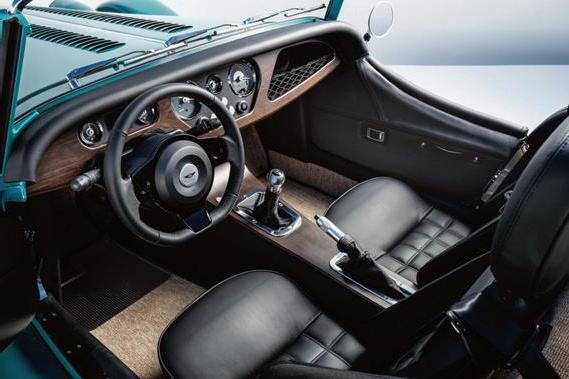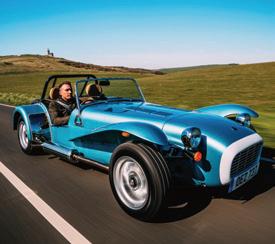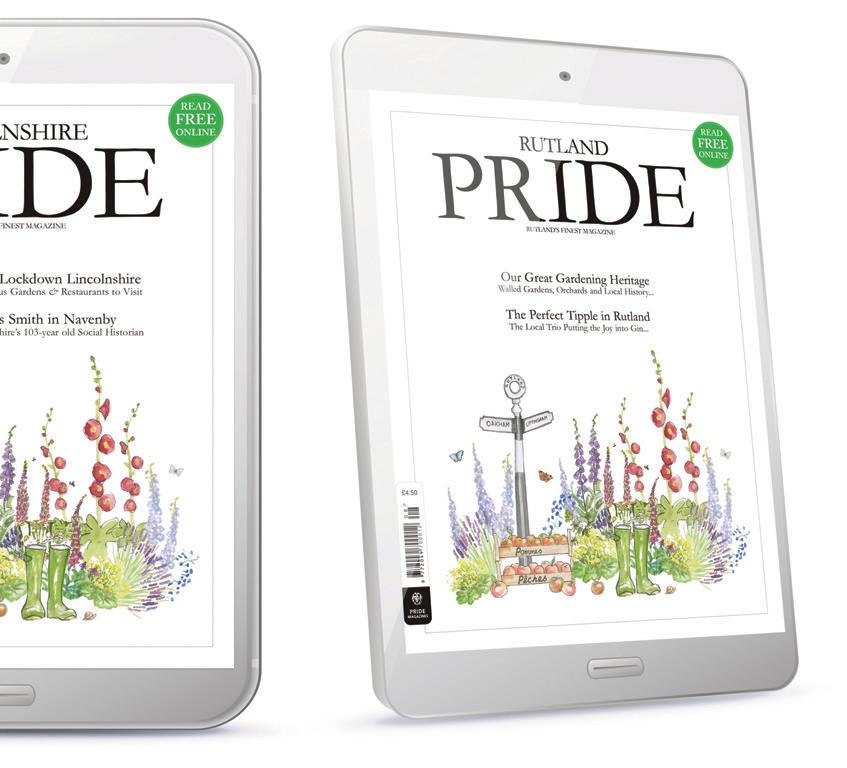
8 minute read
MOTORS Morgan’s new (old) car
MOTORS
VITAL MORGAN
Advertisement
Gloriously and defiantly different, a Morgan has always been the way to defy practicality and break from convention, no wonder Rob Davis is such a fan of this thoroughly British retro rebel...
Words: Rob Davis.
IF YOU COULD GO BACK IN TIME, would you? Really? If you could wind back the hands of the clock and return to your youth? I admit the idea of having hair, losing the paunch, waving goodbye to the fine lines and regaining my youthful optimism does appeal... but alongside the loss of those less desirable characteristics, who would want to return to a time of naivety, to youthful transgressions, failures and insecurities?
That’s the problem with nostalgia, isn’t it? It comes with a tint of rose that colours the past with a decidedly unreal hue. And of course, with age usually comes that feeling of being a little more comfortable in our own skin, indeed, a little more comfortable generally.
I wouldn’t return to an age when smartphones were sci-fi, and when performing one’s ablutions took place in a tin bath by the fire, or when navigation meant maps, not sat navs. In our personal lives, and our homes, and our motors, I generally follow the rule of thumb that nostalgia can take a hike and modern convenience rules OK.

But if there’s one sight guaranteed to make me wonder if, back then, we had it sussed, it’s the joyous, bulbous, swooping, halcyon profile of a Morgan sports car.
Based in Malvern and now 111 years old as a brand, Morgan is perhaps one of the longest-established motoring brands still in its present form today. From the appearance of its cars you’d think time has stood still and development of the brand’s cars has been aspic-like. But as is usually the case, here, appearances deceive and the devil is typically in the detail.
There are three models available in the company’s portfolio; a oddball three wheeler, then the Plus Four and Plus Six, referring to each model’s respective number of cylinders.
This model is the new Plus Four, and it’s newer than you might think, despite the continuity in the car’s appearance. Just 3% of the car’s mechanicals and components are carried over from the outgoing model. A part of the car’s chassis is still crafted from timber, but much of its underpinnings now comprise steel with a bonded aluminium platform.
Hand Built Heaven: Three retro models made manually...


Caterham Seven: With prices starting at £33,495, the 135bhp, five-speed Super Seven 1600 fits perfectly into Caterham’s existing heritage line of products as a permanent addition, alongside the Sprint and Super Sprint models launched in 2016 and 2017 respectively. Inspired by the craftsmanship of the original Super Seven and the early cars created under the historic Caterham badge, the new Super Seven features a raft of retro details and styling cues. These include the classic flared front wings, retro-inspired 14” alloy wheels, a spare wheel and carrier harking back to the touring Sevens of old, and a choice of Seven heritage paint finishes. n


Lotus Elise: The purest useable sports car on sale remains one of the great driving experiences available at any price. Offering 217 hp and 250 Nm of torque, the 1.8-litre supercharged, chargecooled four-cylinder has been tuned to deliver stunning real-world performance and class-leading efficiency. 0-60 mph is now despatched in 4.2 seconds. From £44,600, it’s available in a range of wild colours and though Lotus has opted for a more modern appearance - a sort of shrunken but new GT instead of retro look like models from Morgan or Caterham - the overall look is pleasing to say the least. n


Ariel Atom: Every so often something comes along which changes the way we think. Nobody knows it at the time but it will become an icon. The Ariel Atom is such a product. No doors, no roof, no compromise. It’s unique, it's original and nothing else comes close. Nothing at all. Form following function and design with a purpose. Race car engineering and quality components outclassing every car in its field. Honda 2.0 litre i-VTEC. 16 valves. 60mph is seen off in 2.8 seconds, top speed is 162mph, but you’ll quit way before that. n The aim was to keep the appearance, shed a little weight, stiffen the chassis for a tauter driving experience and - mercifully - to make ingress and egress a little more dignified.
There’s another interesting change from the outgoing model, too. Morgan has always used donor engines from other manufacturers including Ford, and latterly BMW.
The Plus Four uses a 2.0 TwinPower four cylinder engine which generates 350nm of torque in the Morgan, and 400nm in BMW’s 320d SE saloon. However, the Morgan weighs 1,013kg; the BMW weighs about 500kg more, so drivers can gain more thrills from the same engine when it’s underneath the long swooping bonnet of a Morgan than in the more prosaically styled executive saloon.

And there’s something else. The Morgan is now also available with... shock, horror... a thoroughly modern eight-speed automatic gearbox. No clutch; just cruising. And because the BMW-sourced gearbox has been honed in cars like the 3-Series and 5-Series, its changes are so silky smooth you’ll quite soon regard the self-shifter as a blessing, not an aberration.
Inside the cabin there’s the same leather available in 11 colours, a choice of soft grain leathers to cover the dashboard, 16 different colours of carpet, a choice of stitching for the seats, and eight trims including a beautiful matte or gloss tawny veneer. Central locking and power steering are now standard, air con can be specified for the first time. But of course, if you wanted modernity and comfort, you’d look elsewhere. Especially given the choice the £63,000 asking price the Plus Four commands. It takes 9,300 minutes to produce a Morgan, and it’s time well-spent. Mere nostalgia? Perhaps, but with just a hint of civilisation. n
MORGAN PLUS FOUR

Price: £62,995 (available to order now). Drivetrain: 2.0 V4 manual or automatic, 255bhp, 400Nm torque. Performance: 0-62 mph: 5.5 seconds. Top Speed: 149mph. Economy: 40mpg (estimated). Equipment: Leather, power steering, 15” wire wheels, digital instrument binnacle. Optional air con, heated seats, stereo. n

SPACE & COMFORT
The humble estate car has all but ceded its dominance to the almighty SUV. But, says Rob Davis, they’re worth another look... especially Volvo’s spacious and luxurious V90... Words: Rob Davis.
A F EW DECADES AGO, posh folk in the country and rurally situated antiques dealers would have availed themselves of a big boxy Volvo estate to shift grandfather clocks and labradors. Then along came the SUVshaped cars which have proved indomitable in the sales charts ever since.
Estate cars, bless them, have been all but forgotten about, overlooked in favour of higher-riding 4x4s and soft-roaders.
But the humble estate car is still worth a look, expecially Volvo’s excellent V90. For a start they’re lighter, offering better fuel economy and lower company car bills. Riding lower to the ground they’re also better dynamically, with less body roll.
Volvo’s V90 was facelifted last month with a plug-in hybrid drivetrain which lowers CO2 and BIK, achieving 104mpg combined yet outpacing its siblings to reach 60mpg in less than six seconds.
The real selling point of the V90, though, is its massive boot space and beautiful interior. A load-lugger par excellence, with a buttonfree, minimalist interior that’s beautifully finished, you should opt for the blonde, not black, leather and a lighter coloured wood for a spacious and airy cabin feel.
Every V90 is loaded with equipment - heated leather, adaptive cruise, parking camera and navigation are standard - but higher-spec versions are costly. Likewise, if your motoring is predominantly urban, you’ll benefit from the plug-in powertrain but if you sprint along motorways regularly, a diesel may suit your needs better.
For that reason we’d opt for a lower-spec diesel V90, even though the range-topping Inscription with the plug-in hybrid engine is still hugely impressive and refined. n


VOLVO V90 T6 INSCRIPTION
Price: £56,030 (on sale now). Drivetrain: 2.0 V4 petrol with 87hp plug-in hybrid assistance. Performance: 0-60mph 5.6secs, max speed 112mph. Economy: 104.6mpg (WLTP). Equipment: Heated and ventilated massaging leather, adaptive cruise, navigation, wood trim, climate control. n

You can now enjoy your Pride Magazine with our brand new App on your tablet... completely free of charge!

Read online now at www.pridemagazines.co.uk











